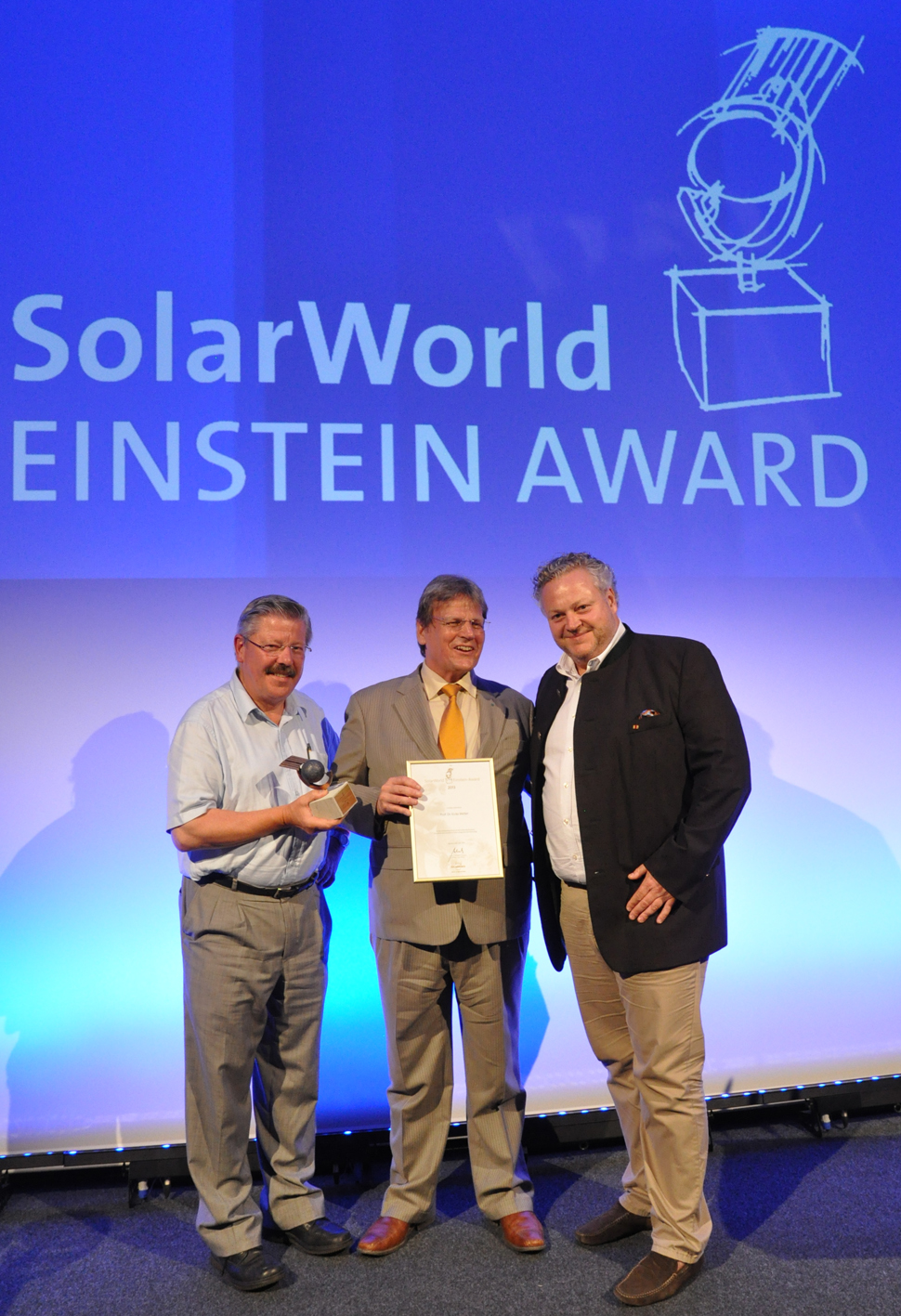Press Release #15
Two Einstein Awards for Fraunhofer ISE: Institute Director Eicke R. Weber receives the Einstein Award 2013 of Solarworld for his Commitment to Photovoltaics in Europe - Junior Einstein Award goes to the young Fraunhofer ISE researcher Pierre Saint-Cast
This year, the Einstein Award of SolarWorld AG and a Junior Einstein Award were awarded to scientists at Fraunhofer ISE. The director of the Fraunhofer Institute for Solar Energy Systems (ISE), Prof. Dr. Eicke R. Weber, was distinguished for his contribution to European solar energy research. The young researcher Pierre Saint-Cast was awarded the Junior Einstein Award for successfully developing a new passivation method for silicon solar cells. Dr. Frank Asbeck, CEO of SolarWorld, praised Prof. Weber as one of the greatest solar researchers in Europe. Under his direction, Fraunhofer ISE develops important know-how for the solar industry and carries it out to application maturity. But his area of work extends beyond this, Frank Asbeck says: “Eicke Weber is one of the European communicators and propagators for solar energy per se. He gave solar energy a voice, which is heard beyond the scientific community and reaches into politics and society at large.”
Photovoltaics is a forward-looking technology and a key cornerstone for a sustainable energy supply with renewable energies. Germany has been a worldwide leader in solar energy research since many years. Now the solar industry in Germany and Europe is heading into difficulty vis-à-vis the competition coming from Asia, especially China. For many years, Eicke Weber has been responding to this situation by campaigning to keep cutting-edge photovoltaic technology in Europe.
“I am extremely delighted about this prize,” remarks Eicke Weber. “It reinforces my efforts in the struggle to keep Europe as a leading location for photovoltaics. Germany and Europe still hold the lead in photovoltaic research and production technology, due not the least to our intensive research in this area.”
“I am convinced that we can reach a global PV market of over 100 GW/year by 2020 and of 300 GW/year in 2025. In order that Germany and Europe can continue to participate successfully in this global market, we need a European initiative similar to the Airbus model. In Europe, we need access to investment funds so that this key technology can develop in fair competition with our Asian competitors”, says the globally connected awardee, emphasizing again that Europe must clearly commit itself to solar energy.
Dr. Winfried Hoffmann, president of the European Photovoltaic Industry Association follows up on this in his laudation for the Einstein Award 2013. He wishes the awardee Eicke Weber courageous undertakings in which the wealth of ideas found in research are implemented in the practice. “One example could be the construction of multi-gigawatt scale manufacturing facilities for wafers, cells and modules,” says Hoffmann. “Serving as a beacon for the European PV industry, this project can point the way into the future.”
Pierre Saint-Cast receives SolarWorld Junior Einstein Award
The young researcher Pierre Satin-Cast was distinguished for developing a new method of passivation on silicon based solar cells. His work in this area resulted in a remarkable efficiency increase of one percent. “I am elated to receive the SolarWorld Junior Einstein Award,” says the happy prize winner. “The aim of my work is to develop methods for increasing efficiencies, which, in turn, can quickly be transferred to the industrial production level. That this work is recognized with such a reputable prize is a great success!”
Five years ago, Saint-Cast came to Fraunhofer ISE as a doctoral student to work in the division of “PV Production Technology and Quality Assurance” and study the electrical losses on the back side of solar cells. His goal was to find a passivation layer that made it possible to reduce these losses. The post-doc at Fraunhofer ISE reached his goal. In a plasma reaction, he produced aluminum oxide and applied it to the wafer backside. Through this passivation, the light on the backside is no longer absorbed, but rather reflected back into the cell. Thanks to Saint-Cast’s calculations, the energy losses on the backside of the solar cell are reduced to a minimum. As a result, the efficiency of these new solar cells is about one percent higher than that of conventional cells. Especially notable is the fast transfer of his research results to the industry. Only two years after the first positive results, the newly developed processes were transferred to the industry.
Since 2005, the Einstein Award is awarded to persons who have especially distinguished themselves in promoting the use of solar energy as an energy source of today and the future and thus for the Earth. To date, winners of the Einstein Award include: Dr. Hermann Scheer, Prof. Dr. Klaus Töpfer, Prof. Dr. Adolph Goetzberger, Prof. Dr. Martin Green, Prof. Antonio Luque Lopez, Dr. Rupert Neudeck and Prof. Yunus Muhammed as well as the SMA founder Günter Cramer.
As the oldest and most renowned award of its kind for young researchers in this branch, the SolarWorld Junior Einstein Award promotes young scientists and their ideas in the field of photovoltaics since 2006. Premiered are excellent degree theses that are characterized by courageous ideas, relevance to the practice and founded theoretical research.
Last modified:
